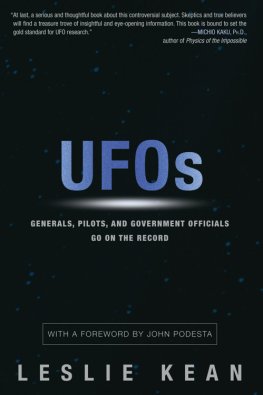Contents
Page List
Guide

SEARCH FOR THE UNKNOWN
Search for the Unknown
Canadas UFO Files and the Rise of Conspiracy Theory
MATTHEW HAYES
McGill-Queens University Press
Montreal & Kingston London Chicago
McGill-Queens University Press 2022
ISBN 978-0-2280-1074-6 (cloth)
ISBN 978-0-2280-1229-0 (ePDF)
ISBN 978-0-2280-1230-6 (ePUB)
Legal deposit second quarter 2022
Bibliothque nationale du Qubec
Printed in Canada on acid-free paper that is 100% ancient forest free (100% post-consumer recycled), processed chlorine free
This book has been published with the help of a grant from the Canadian Federation for the Humanities and Social Sciences, through the Awards to Scholarly Publications Program, using funds provided by the Social Sciences and Humanities Research Council of Canada.
We acknowledge the support of the Canada Council for the Arts. Nous remercions le Conseil des arts du Canada de son soutien.
Library and Archives Canada Cataloguing in Publication
Title: Search for the unknown : Canadas UFO files and the rise of conspiracy theory / Matthew Hayes.
Names: Hayes, Matthew (Historian), author.
Description: Includes bibliographical references and index.
Identifiers: Canadiana (print) 2021036355X | Canadiana (ebook) 20210363649 | ISBN 9780228010746 (cloth) | ISBN 9780228012290 (ePDF) | ISBN 9780228012306 (ePUB)
Subjects: LCSH: Unidentified flying objectsSightings and encountersCanadaHistory20th century. | LCSH: Unidentified flying objectsGovernment policyCanadaHistory20th century. | LCSH: Government informationCanadaHistory20th century. | LCSH: Conspiracy theoriesCanadaHistory20th century.
Classification: LCC TL789.6.c3 H39 2022 | DDC 001.9420971dc23
This book was typeset in 10.5/13 Sabon.
Contents
Figures and Plates
FIGURES
PLATES
Acknowledgments
This book began its life as a PhD dissertation in the School for the Study of Canada at Trent University. I owe thanks to a number of people there, who provided patient and encouraging guidance, foremost among them: my supervisor Christopher Dummitt, my committee members Peter Hodgins and Edward Jones-Imhotep, and the schools administrators Cathy Schoel and Jeannine Crowe. I benefitted greatly from the chance to speak about my project on the cbc program Ideas, which helped me make sense of what I was trying to say. Thank you to Nicola Luksic and Tom Howell for the opportunity. One day, out of the blue, Kyla Madden from McGill-Queens University Press reached out to me to talk about a possible book. I am grateful that she did so. I cannot thank Kyla enough for her patience and expert editorial guidance on turning my dissertation into this book. Thanks also go to a number of other people who have provided invaluable assistance along the way: Christopher Ryan, Leah Weiner, Veronique Paris, Wendy Robicheau, Laura Thursby, and Noah Morritt. Lastly, I want to thank all the civil servants and ufologists who have worked to understand what this whole UFO phenomenon amounts to. They have often disagreed with one another (and probably still do), yet their interactions are the reason I was able to do this project at all. Whatever UFOs turn out to be, I am grateful for their efforts.
Abbreviations
| CAPIC | Canadian Aerial Phenomena Investigations Committee |
| CAPRO | Canadian Aerial Phenomena Research Organization |
| CFB | Canadian Forces Base |
| CFHQ | Canadian Forces Headquarters |
| CUFOR | Canadian UFO Research |
| DND | Department of National Defence |
| DOT | Department of Transport |
| DRB | Defence Research Board |
| JIC | Joint Intelligence Committee |
| LAC | Library and Archives Canada |
| NICAP | National Investigations Committee on Aerial Phenomena |
| NRC | National Research Council |
| PM | Project Magnet |
| PSS | Project Second Storey |
| RCAF | Royal Canadian Air Force |
| RCMP | Royal Canadian Mounted Police |
| UOA | University of Ottawa Archives |
| UFO | unidentified flying object |

Plate 1 | Drawing of UFO typical of the sort that accompany many sighting reports. This example depicts a classic-type domed flying saucer, described simply as shiny and metallic, with a tail-light. There is no sense of scale or position, other than a crescent moon. The note at the top What I saw in the sky on July 2, at night provides no information that would help identify the object. Investigators found it difficult to make use of such drawings, and generally did not take them seriously.
Plate 2 | Sometimes witnesses felt the need to draw what they saw immediately, before the details slipped away. And sometimes in such moments, all the paper they had to hand was stationary from a hotel or bar in this case, a pad advertising Royal Canadian whisky.
Plates 34 | More often than not, UFO drawings by citizens looked like these: rudimentary, with scant detail and little or no sense of scale or setting. It is hard to glean much from drawings like these, posing a problem for investigators: what to do with them?
Plate 5 | Electron UFO. The centre portion of this drawing, from July 1992, resembles two electrons orbiting one another. That is likely not what the witness intended, but we tend to project our imaginations onto drawings such as this, which are ambiguous enough to invite multiple readings. In this case, at least, the artist gave the object shading to indicate texture.
Plate 6 | Wavy UFO. This drawing is typical as the hues indicated red, yellow, and orange were the most commonly reported colours of UFO lights. In fact, often reported sightings were simply sightings of lights, without any craft. This UFO appears to have a domed top, another characteristic feature of many drawings.

















